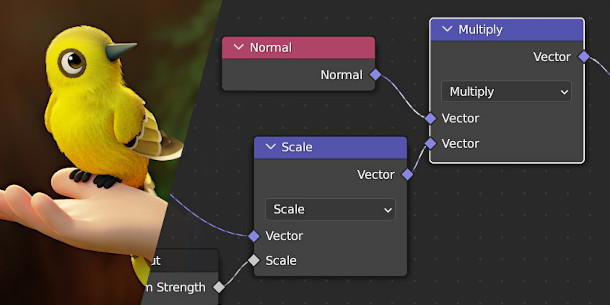Check out the Blender 3.x product roadmap

Blender Foundation chairman Ton Roosendaal has posted an outline roadmap for Blender 3.x, the next two-year cycle of updates to the open-source 3D software.
Changes proposed for the release cycle, which is due to run from Blender 3.0 this December to Blender 3.7 in 2023, include major updates to Blender’s physics, sculpting and character rigging toolsets.
Blender will also “move entirely” to the Vulkan open standard for GPU computing, with new Vulkan and Metal backends replacing OpenGL by the end of 2022, and GPU ray tracing via Vulkan in the Eevee render engine.
Blender 3.0: new asset manager, USD importer and Cycles X
The Blender Foundation announced in 2020 that it proposed to end the 20-plus-year Blender 2.x release series this year, in favour of a new two-year update cycle.
The first release in that series, Blender 3.0 – originally scheduled for this August, and now due to ship in December 2021 – is already well on in development, with new features including a new asset manager, USD import, and Cycles X, the much-anticipated rewrite of Blender’s Cycles production render engine.
The proposed roadmap sets out the goals for the remaining updates, Blender 3.1 to 3.7, in broad strokes: with a few exceptions, it doesn’t assign exact version numbers or release dates to the changes.
Future releases: major updates to physics and character animation
Most parts of the software described as “quite stable”, but major changes are proposed to several key toolsets, including physics, character rigging and animation, sculpting and texturing.
Of those, the furthest advanced is probably physics, with the Blender Foundation proposing to expand the new geometry nodes system introduced in Blender 2.92 into a broader project dubbed ‘everything nodes’.
The initial goals are to extend the new node-based architecture to particle and physics simulations, with a new hair simulation system further in the future.
Blender 3.x will also retain the software’s existing physics systems, including Bullet physics for rigid bodies, Mantaflow fluid simulation, soft bodies and cloth, but add a new OpenVDB modifier for volumes.
The changes to character rigging and animation are also fairly well established, having initially been proposed as the ‘Animation 2020’ project, then postponed due to the COVID-19 pandemic.
Funding for the work has also already been provided by Amazon Web Services, which specifically cited the project when it became a corporate patron of the Blender Development Fund last year.
According to the roadmap, “keywords are: node-based, layering, debugging tools, speed, crowds, mocap support [and] automated systems for muscles and physics”.
Clay brushes in use inside a “performance prototype” of Blender. A novel new hybrid 3D sculpting and painting workflow is one of the major changes proposed for the Blender 3.x release cycle.
A novel new hybrid 3D sculpting and painting system
The other big changes are less fleshed out, and include a proposed hybrid sculpting and painting workflow.
The roadmap describes it as a “novel approach to combine traditional (triangle offset) sculpting with shader-based texture displacement”, capable of generating fine detail without the need for high polygon counts.
The changes to Blender’s procedural texturing system are simply described as “an open topic”, although the roadmap notes that the toolset is in “urgent need” of an update.
Transition from OpenGL to Vulkan and Metal due by the end of 2022
Another key goal is to “move Blender to entirely use the Vulkan open standard” for viewport display.
New GPU backends for Vulkan and Apple’s Metal API – the latter being created by Apple itself – are already in development, and are due to replace the old OpenGL backend “by the end of 2022”.
The change also “paves the way” for GPU ray tracing via Vulkan in Eevee, Blender’s real-time renderer.
In addition, the roadmap proposes a new real-time compositing system that will “[bring] compositing nodes into the 3D viewport”, working on render passes generated in Eevee.
New systems for creating custom versions of Blender and providing integrated online services
Other proposed changes include a new Blender Application Template system, intended to enable scripters to create custom versions of Blender with alternative UI layouts and keymaps.
The system is currently due in beta in Blender 3.1 next spring.
In addition, work will begin on Meta, a new module intended to enable Blender to connect to the web for “additional features” like update notifications, accessing asset libraries, or collaboration environments.
Services provided through a new proof-of-concept website, meta.blender.org, will be free, only requiring an account to log in, with “possible commercial add-ons” provided separately by independent vendors.
Pipeline integration and compatibility-breaking changes
Changes affecting pipeline integration include “further integation” of the Universal Scene Description framework, following the release of the new USD importer in Blender 3.0.
Support for the increasingly significant materials standard MaterialX is “on the list to be discussed”.
Although the roadmap notes that the aim will be to keep new functionality compatible with the 2.8x releases, “some [compatibility] breaking changes to the API are inevitable”, the biggest of which will be the deprecation of BGL, Blender’s old OpenGL wrapper, in favour of a new GPU module.
System requirements and release date
Blender 3.0 is due for a stable public release in December 2021. The current stable release, Blender 2.93, is available for Windows 8.1+, macOS 10.13+ and Linux. It’s a free download.
Read the proposed Blender 3.x roadmap on the Blender Developers blog
Read more about the new features in Blender 3.0 in the online release notes
(Still a work in progress until the final release)
